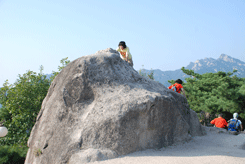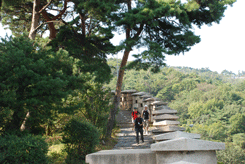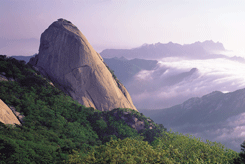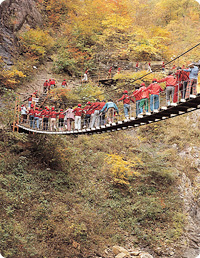National Park
 |
 |
 |
Bukhansan(Central region)
It is also known as Bugak, or Samgaksan (Triangle Mountain). Bukhansan National Park is so close to Seoul that more than 10 million people visit every year, and is the ideal place to hike and take a break escaping out of hectic city life. The park was designated as 15th national park in Korea, in 1983. It spans an area of 80㎢ including the adjacent Dobongsan. This national park covers two administrative districts Seoul and Gyeonggi-do province. There are not many rare species of animals and flora in the park compared to other national parks of the country since it is entirely surrounded by cities, but it is considered the “green lung” for millions of citizens who live around this area. The park is easily accessible by the public transportation and is visited by over four million people each year. The name “Samgaksan" was granted Bukhansan because Baegundae (836.5m), Insubong (810.5m), and Mangyeongdae (799.5m) forming a triangle. However, its name was later changed to Bukhansan during the period of King Sukjong of the Joseon Dynasty, after Bukhansanseong (mountain fortress wall) was built. This national park is situated in a mountain range stretching from north to south with 20 other peaks, including Insubong, Mangyeongdae, Baegundae, Nojeokbong, Bibong, Wonhyobong, Jaunbong, Manjangbong, Seoninbong, and Obong. Uiryeong ridge draws the boundary line between Dobongsan in the north and Bukhansan in the south.
The park has steep rocky cliffs and precipitous mountains, dissected by many valleys. From the Paleozoic era, the granite ground rose and eroded over a long period of time, and the rocks were made into fantastic formations. The mountain, considered the holy mountain of Seoul, has a long history and boasts many historical remnants and relics. There are 1,300 species of fauna, including smaller mammals, amphibians, reptiles, insects, and birds that can still be seen here. The park has various plants including oak trees, maple trees, azaleas, and beautiful flowers from spring to autumn. In spring, all kinds of flowers bloom and turn the park into a fairyland. In summer, the streams flow through the cool shade of the dense forests - an ideal place to seek refuge from the summer heat.






